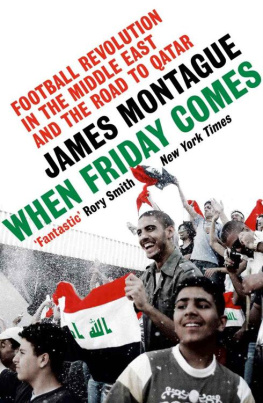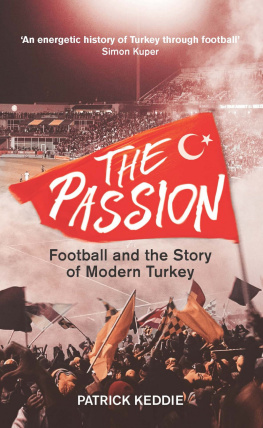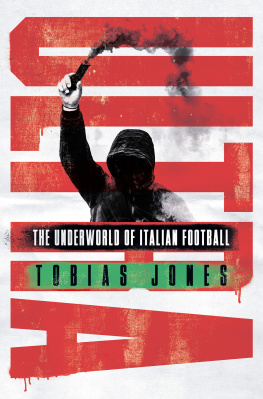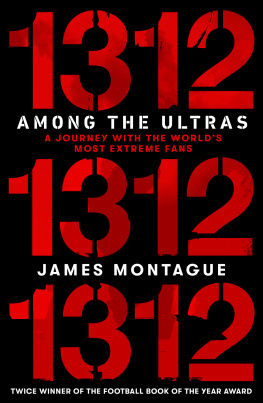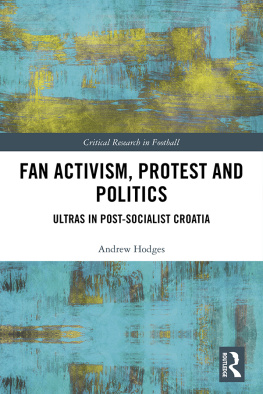Ultras
Ultras
The passion and performance of contemporary football fandom
Mark Doidge, Radosaw Kossakowski and Svenja Mintert
Manchester University Press
Copyright Mark Doidge, Radosaw Kossakowski and Svenja Mintert 2020
The rights of Mark Doidge, Radosaw Kossakowski and Svenja Mintert to be identified as the authors of this work have been asserted by them in accordance with the Copyright, Designs and Patents Act 1988.
Published by Manchester University Press
Altrincham Street, Manchester M1 7JA
www.manchesteruniversitypress.co.uk
British Library Cataloguing-in-Publication Data
A catalogue record for this book is available from the British Library
ISBN 978 1 5261 2762 4 hardback
First published 2020
The publisher has no responsibility for the persistence or accuracy of URLs for any external or third-party internet websites referred to in this book, and does not guarantee that any content on such websites is, or will remain, accurate or appropriate.
Cover: Photo by Mark Doidge
Typeset in Sabon and Gill Sans by
Servis Filmsetting Ltd, Stockport, Cheshire
Contents
Writing a book is not just a collaboration between the authors, but a whole network of people. The authors would like to thank Tom Dark at Manchester University Press for his patience (and we hope it was worth the wait).
A book about ultras would not be possible without the ingenuity, passion and creativity of football fans across the globe. The dedication, desire and commitment of so many fan groups provide such a rich seam of activities which a book like this can only touch upon.
Mark would like to thank his partner, Momtaz, for her support throughout the process and the emotional labour of encouragement and reassurance. He would also like to reiterate his support and thanks to Football Supporters Europe (FSE) and Endi and Ronan in particular who perform such an important role in European football fandom. Their annual networking meetings and congresses bring together so many active fans to discuss the real issues affecting football supporters. Just being linked to FSE provides so many insights into what is happening across European fan cultures. Finally, he would also like to thank his colleagues in the Sport and Leisure Cultures research cluster at the University of Brighton. Discussions here, and with Tom Carter in particular, provide so much intellectual nourishment to explore ideas and analyses that hopefully find expression in these pages.
Radosaw would like to thank his family for their permanent support. He appreciates also the intellectual and research journeys with many colleagues engaged in football studies and the sociology of sport.
Svenja would like to thank all the talented young researchers who were involved in realising the findings in this book. Their significant inspiration, critical thoughts and valuable insights provided constant support and were at all times highly appreciated.
We would also like to acknowledge the generosity of funders in enabling aspects of this book to come together. Consequently, some data used and analysed in this book have been collected thanks to a research grant funded by Polish National Centre of Science (no. 2013/09/D/HS/6/00238; principal investigator Radosaw Kossakowski) and within in the framework of Football Research in an Enlarged Europe (FREE), which received funding from the European Unions Seventh Framework Programme for research, technological development and demonstration under grant agreement no. 290805.
All the hot, sweaty bodies collapsed domino-like onto the searing heat of the concrete stand. The home team, Livorno, had just scored against Pisa, their hated local rivals. The joy sparked a euphoric reaction with thousands of fans jumping, hugging and cheering. In the maelstrom of relief, ecstasy and Schadenfreude that the goal elicited, bodies became unstable and crumpled onto the seats of the stadium. They became one mass of flesh, clothing and flags. On the pitch, the players were running to the fans, embracing each other and raising their fists to the air in exaltation. Through their displays of emotion, they acknowledged the importance of the goal to the fans of Livorno, and by extension the citys inhabitants who have a longstanding rivalry with Pisa that pre-dates the codification of football in the nineteenth century. As play restarted, the fans were back on their feet, all the flags were waved wildly and the volume of the songs lauding the city of Livorno were significantly amplified. The intensity of the chants increased as more fans joined in, while the capos at the front exaggerated their direction of the curva to bring more fans into the performance. The collective outpouring of emotion was incongruous, as the goal seemed to come from nowhere; there had been no sustained passage of play that suggested a goal might be scored. Pisa had dominated possession for a few minutes, yet Livorno broke away to land the classic sucker punch and produce delirium among their fans. Only moments before that delirium there was a collective intake of breath as the home player sprinted towards goal; the Livornese had a very different set of emotions. But in the seconds after the ball hit the net there were two clear groups: Livornese and Pisans; and they were clearly divided by the emotions they felt.
The joyous, chaotic mass of bodies signifies the importance of emotions in creating the social collective. Although Livornos defeat of Pisa was an emotional moment in the history of Livornese football, it was not unique in the football world. The atmosphere in a football stadium is a ritual that is actively performed by the fans. The ecstasy of Tottenham fans celebrating Lucas Mouras ninety-fifth-minute winner in their 2019 Champions League semi-final contrasts sharply with the deflation experienced by the fans of Ajax in the rest of the stadium. The bitterness Fiorentina fans hold towards Juventus endures decades after the Turin side snatched the 1982 Serie A title on the last day of the season. Across the globe, one particular group has taken a leading role in creating these highly passionate atmospheres: the ultras. They produce choreographies (also known as tifos or choreos) that regularly involve collective chanting, flags, banners, clothing and pyrotechnics. For bigger matches, such as local derbies, spectacular choreographies will be displayed that can cover the whole terrace (or curva ) and can take many weeks to fund, design, paint and prepare. These can include paintings on gargantuan sheets of fabric or designs that require a variety of coloured cards. Ultras are obsessed about the collective performance, unity and harmonisation, and this is not only what distinguishes them from other football fans but also from many other forms of collective behaviour. Ultras are one of the only groups displaying collective behaviour that pride themselves on having a shared, coherent sense of identity based on an act of consumption: that of football.
This book marks half a century of the ultras phenomenon. Although passionate fans have been following football since the beginning, and certain elements of the ultras style existed elsewhere (notably with the Torcida group in Split, Croatia), the ultras can date their formation back to AC Milans Fossa dei Leoni in 1968. Few cultural activities engage as many people as football, and within football fandom, the ultras are overwhelmingly the most widespread and powerful group of fans in the world. It is for this reason that they represent an important group for social analysis. There are few social groups in the world that have the global reach, visibility and regular mobilisations of the ultras. Even though these groups are only loosely affiliated some will work together, others will not there is a coherent identification with the ultras way of life. It is for this reason that they represent an important case study in contemporary consumer culture.


